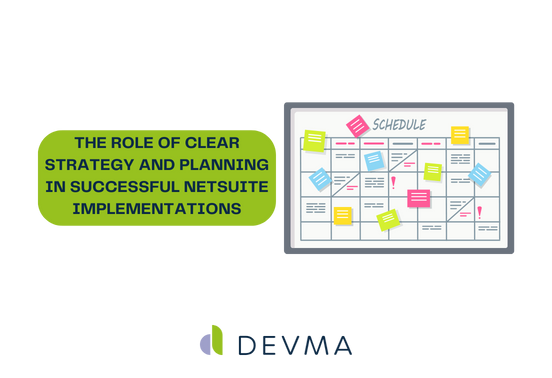Last update: Nov 19, 2024
The Role of Clear Strategy and Planning in Successful NetSuite Implementations

Table of contents
- 1. Set Clear Objectives and Success Metrics
- 2. Engage in Thorough Planning and Discovery
- 3. Involve Key Stakeholders from the Start
- 4. Prioritize Data Quality and Migration
- 5. Customize Thoughtfully
- 6. Provide Comprehensive Training
- 7. Emphasize Change Management
- 8. Focus on Continuous Improvement
- Achieving Success with Strategic NetSuite Implementation
Rolling out NetSuite can transform your business operations, but it takes a bit more than a quick software installation. Effective NetSuite implementation hinges on strategic planning, clear goal-setting, and precise execution. Whether you’re transitioning from a legacy system or integrating NetSuite into an established, complex structure, a clear roadmap can optimize processes and set a solid foundation for growth.
1. Set Clear Objectives and Success Metrics
Before starting your NetSuite journey, define specific goals for what you want to achieve with the ERP implementation. Is the focus on optimizing inventory management, improving customer service, or gaining real-time financial visibility? Establishing these goals will help guide your NetSuite implementation strategy and keep your team aligned. Additionally, identify key performance indicators (KPIs) to measure success at various stages of the implementation. By setting these metrics early, you can better track ROI and make informed adjustments.
2. Engage in Thorough Planning and Discovery
Good planning is the backbone of any successful NetSuite implementation. Collaborate with a NetSuite consulting team to conduct a detailed discovery process, examining existing workflows, understanding system requirements, and identifying any customization needs. A robust planning stage will uncover potential challenges and ensure that the ERP solution aligns with your organization’s unique operational needs.
3. Involve Key Stakeholders from the Start
ERP implementation will affect multiple departments, from finance and sales to customer service and inventory management. Ensuring a smooth NetSuite rollout requires buy-in from key stakeholders across these departments. Encourage early engagement by involving department leads in discussions about the system’s design, functionality, and expected outcomes. Their insights can lead to better customizations and a higher adoption rate once the system goes live.
4. Prioritize Data Quality and Migration
Data migration is one of the most critical aspects of a NetSuite implementation. Before migrating data, conduct a thorough audit to ensure accuracy, consistency, and relevance. Cleaning up outdated or redundant information will streamline the migration process, prevent errors, and help the new system function optimally. Work with NetSuite consultants who specialize in data migration to establish best practices for data mapping, cleansing, and verification.
5. Customize Thoughtfully
NetSuite’s customization options are a double-edged sword—useful but potentially overwhelming. NetSuite offers a high degree of customization, allowing businesses to adapt the software to their specific workflows. However, over-customizing can complicate future upgrades and create maintenance challenges. Collaborate with experienced ERP implementation on strategy experts to identify essential customizations that will support your operations without compromising system scalability and flexibility.
6. Provide Comprehensive Training
A successful NetSuite implementation doesn’t end on deployment day. For the most impact, invest in comprehensive training programs to equip your team with the skills to use NetSuite effectively. Partner with NetSuite consulting professionals to develop customized training sessions that address each department’s specific needs. By building a knowledgeable user base, you’ll reduce resistance to the new system and enable smoother day-to-day operations.
7. Emphasize Change Management
Change management is often overlooked in ERP implementations but is essential for sustained success. Prepare your team for the new system by communicating the benefits and addressing any concerns about the changes in workflows or roles. Keeping an open line of communication and offering ongoing support will help ease the transition and boost overall satisfaction with the system.
8. Focus on Continuous Improvement
NetSuite implementation is not a one-time project but a long-term investment in business growth. After the initial deployment, establish a process for continuous improvement to optimize the system as your business evolves. Regularly review performance metrics, gather feedback from users, and make adjustments to the system configuration or add modules as needed. This ongoing optimization will ensure that your ERP implementation on strategy continues to deliver value as your organization scales.
Achieving Success with Strategic NetSuite Implementation
Implementing NetSuite can transform your business operations, but the journey requires strategic planning, stakeholder collaboration, and a commitment to continuous improvement. By following these NetSuite implementation strategies, you can build a system that aligns with your goals, empowers your team, and sets your business up for sustained success.